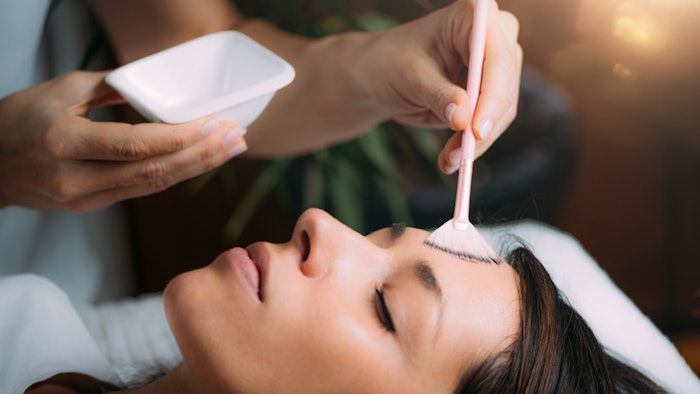
This month we asked industry pros for their input on peel safety, treatments and products. We have gathered expert advice from industry professionals on peel treatments, and we are bringing these tips to you.
Tip 1: Offer Peels for Every Skin Care Concern
Be your client’s number one source for their skin wellness goals by prescribing home care peels for maintenance, along with recommended advanced peels in the treatment room. Whether you are treating acne, premature aging, or anything in between, having both retail and facial treatments available will further the health of your client’s skin, as well as ensure client loyalty. As a licensed professional, your number one job is to be the solution to your client’s skin concerns.
—Gina Marie McGuire, GINAMARIE Skincare
Tip 2: Good Skin Health is a Must
For a chemical peel to go well and prevent unintended side effects both during and after the procedure, the skin has to be in good health. A minimum of four to six weeks of consistent home care is a must for clients prior to the peel. A full skin care routine consisting of professional grade products such as a pH balanced cleanser, barrier strengthening peptide serums, and a nourishing moisturizer are essential to preparing the skin to accept the chemical solution, and provide a successful healing process and treatment results.
—Mark Viktora. Director of R&D at Viktoria Deann Cosmeceuticals
Tip 3: Peel Consistently to Repair While Preventing Skin Damage
Peels are an effective method to decongest and detox pores, minimize fine lines and even skin tone. I recommend that clients receive a professional peel monthly alongside a facial while continuing their home care regime, including additional exfoliation twice a week. Peels and exfoliation help repair while also taking preventative measures.
—Tag Ceder, Spa Consultant and Industry Expert
Tip 4: Look for Natural Alternatives for Acid Peels
For those avoiding acid peels, organic spas may offer alternative treatments, such as face massages using slices of eggplants or mushrooms. Mushrooms naturally contain kojic acid, aiding in discoloration reduction and skin lightening. Additionally, the high antioxidant concentration in store-bought mushrooms aids in restoring skin cells affected by oxidative stress.
—Elina Fedotova, Founder of Elina Organics Skincare
Related: Rejuvenating Skin With Peels
Tip 5: Provide Gentle, Yet Effective Results with Peel Series
Modern chemical peels differ from those in the past, replacing old-school methods with a new approach that aims to rejuvenate the skin without causing traditional side effects like redness, flaking, irritation, pigmentation or scarring. The contemporary peels are safer, milder and deliver superior results when administered in a series.
—Candace Noonan, LE, COE and Director of Education for DermaConcepts
Tip 6: Lightly Exfoliate Before Peel Treatments
My favorite way to boost peel efficacy is to do some type of mechanical or enzymatic exfoliation beforehand. Removing or dissolving the top layer of skin allows the peel to penetrate easier and more evenly. I always use blended peels with added support ingredients like tranexamic acid (TXA) and hexylresorcinol for more targeted results.
—Danae Markland, VP of Clinical Development & Partnerships for Linder Health
Tip 7: Educate Clients on Proper After-Care
Clients love immediate results! Peels are effective treatments for your client to leave with smoother, glowing skin. Microdermabrasion and glycolic acid peels help reduce the appearance of fine lines, wrinkles and dark spots. While the peel treatment itself is a pivotal step in your client’s skin care journey, an in-depth post-peel skin care routine ensures lasting beauty. After the peel treatment, guide your client on proper skin care and sun protection. Appropriate post-peel care not only enhances your client’s results, but also guarantees they’re getting the most out of their treatment.
—Jeanine Faust, President and Owner of UBS Aesthetics / Distributor of PowerPeel
Tip 8: Make Sure Your Client is a Suitable Peel Client
When engaging in discussions about peels with guests, it’s crucial for them to recognize their pivotal role in achieving desired results. A significant 70% of the outcome is attributed to their commitment to post-facial aftercare. Providing a comprehensive at-home step-by-step guide, detailing dos and don’ts, becomes imperative for their success. It’s essential to acknowledge that not all guests may be suitable candidates for peels if they are unwilling to adhere to your guidance. Enhancing the aftercare experience can be facilitated by offering an at-home skin care kit as part of the facial, ensuring optimal results. The key to the success of any peel lies in maintaining consistent hydration post-treatment, fostering the development of a new, vibrant skin tone and texture.
—Rachael Gallo, esthetician and Chief Operating Officer at Silver Mirror Facial Bar
Tip 9: Utilize Lower Percentage Acid Peels
Professional chemical peels remain one of the most efficacious, cost effective treatments available to address a variety of skin conditions. Blends of multiple, lower percentage acids are preferable over high percentage single acid solutions, as they allow you to treat a wider variety of patients. Also, look for formulas that contain additional ingredients that support the particular conditions you are looking to treat that will provide you with more targeted treatment solutions.
—Alison Adams-Woodford, PCA SKIN Senior Education Manager, Research and Communications











